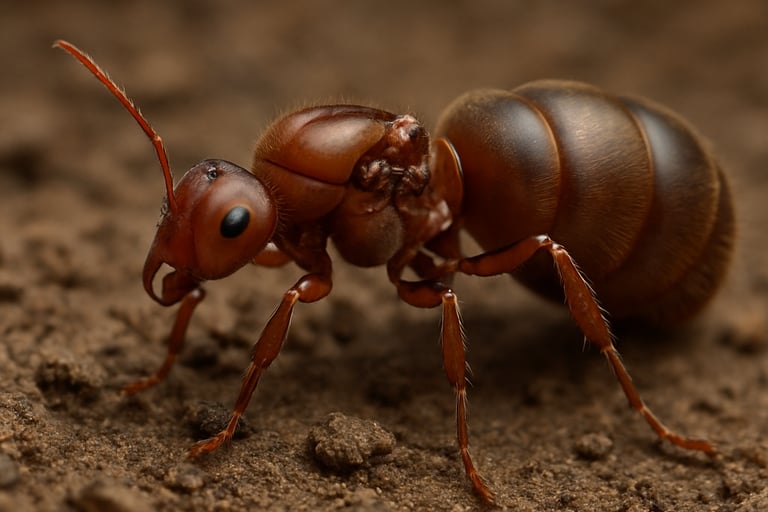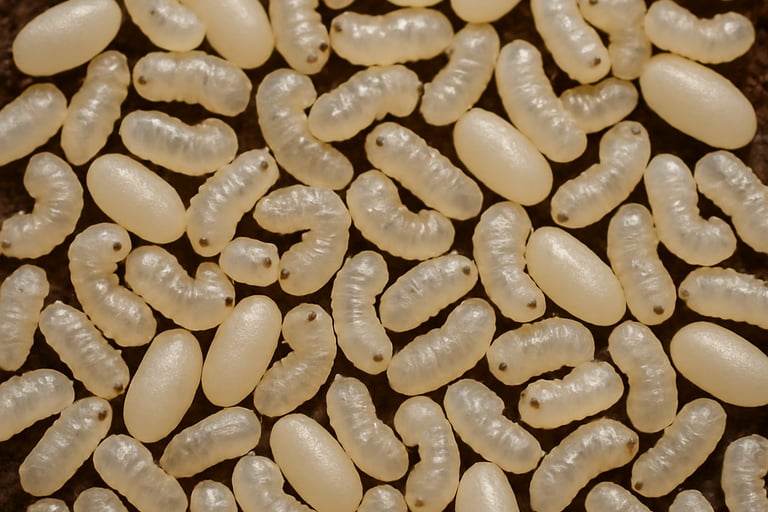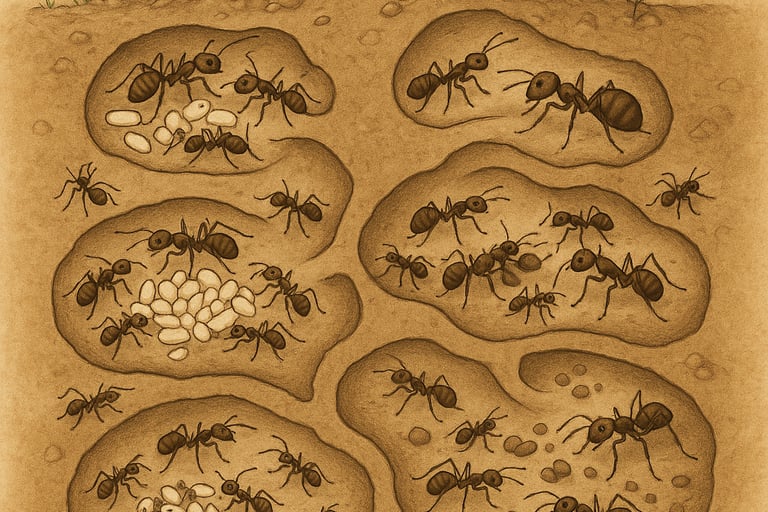Ants: The Architects of Unity and Resilience
There is a world beneath our feet—quiet, tireless, and full of wonder. A world where purpose flows in every movement, and strength is found in togetherness. If such life stirs your curiosity, pause a while and look closer. There’s much to learn in their way of being.
CURIONIS


Hidden beneath the soil's surface lies a bustling world built on relentless effort and silent cooperation. In this realm, ants function not as individuals but as integral parts of a cohesive unit. Their lives revolve around a continuous cycle of tasks, driven by instinct and unwavering dedication to a queen they may never see. This society, simple in structure yet complex in function, balances delicacy with endurance.
What makes this world extraordinary is the way these tiny creatures establish colonies, nurture their leaders, and sustain life with remarkable precision. To understand this, let us journey downward, layer by layer, into a world unseen—where the ordinary becomes remarkable, and the tiny reign with quiet majesty.
In this hidden society, leadership isn't inherited but cultivated through care and purpose. Every potential queen starts life as an ordinary egg, indistinct from her sisters. Her path to royalty is determined not by lineage but by nourishment. When the colony senses the need for a new queen, it selects certain larvae for a special diet rich in proteins, altering their development. Wings form, reproductive systems activate, and an ordinary larva gradually transforms into a queen.
Once transformed, young queens do not linger in the sheltered chambers where they were raised. Their purpose lies elsewhere. On warm, humid days, they take to the sky in a nuptial flight, rising alongside countless others in a brief, instinctive surge of life. There, high above the ground, each queen mates with several males, gathering the genetic legacy she will carry for the rest of her life. The sky becomes both cradle and crucible—only the swiftest and strongest males succeed in this fleeting union. Yet even those who never mate meet the same fate, for their lives are designed for a single purpose. Lacking the tools to survive beyond the flight, they soon drift from the sky, their role in the story—triumphant or not—drawn to a quite close. This aerial rite ensures that mating takes place far from the crowded colony, reducing the risk of inbreeding and dispersing new queens to distant lands, where they may begin anew, carrying the flame of a future colony within them.
After mating, the queen descends to the ground, seeking a suitable place to start her colony. In a secluded spot—beneath leaves, between stones, or in a self-dug chamber—she sheds her wings, a one-time act signifying her new life. The nutrients from her wings help sustain her during the initial solitary phase.
Alone, the queen relies on her stored reserves to survive. She lays her first batch of eggs, tending to them diligently. Upon hatching, she feeds the larvae with secretions from her body. These first workers, though smaller due to limited resources, are vital—they take over foraging, nest expansion, and caring for subsequent broods. They are the first breath of the colony.
With the emergence of her first workers, the queen's responsibilities shift. No longer does she forage, clean, or guard; these tasks are now undertaken by her offspring, who venture out to gather food, expand the nest, and care for the new brood. The queen retreats into seclusion, dedicating her life to laying eggs, sustained and protected by the very generations she brings forth. What began as a solitary descent becomes the foundation of a complex society. At its core lies the queen—once a daughter of the sky, now the silent architect of an underground world. As the colony matures, the queen withdraws deeper into her chamber, a realm untouched by light. Here, time is marked by cycles of growth and renewal, each egg a continuation of her enduring purpose.
The queen lays eggs not as a single act, but as a continuous cycle—her role shaped not merely by instinct, but by the unyielding demands of a flourishing colony. In the warmth of spring and summer, when the earth stirs and food is abundant, her fertility surges. She may lay hundreds, even thousands, of eggs each day, her pace driven by the needs of her species and the growing strength of her colony. As winter approaches, or during colder spells, her laying slows, and in some climates, she may cease altogether, conserving her energy until the seasons shift again.
Remarkably, she never mates again. The solitary flight that once sealed her fate in the sky provides all she will ever need. The sperm she carries, gathered from those fleeting, aerial encounters, remains stored in her spermatheca—an organ designed to hold and release it with precision. With this finite reserve, she fertilizes eggs sparingly and with purpose. Fertilized eggs become daughters—tireless workers and future queens. Unfertilized eggs, however, are laid without the need for mating, thanks to the unique system of haplodiploidy. In this process, unfertilized eggs develop into males, as they carry only one set of chromosomes from the queen, while fertilized eggs carry two sets, one from the queen and one from the male. This natural mechanism, through parthenogenesis, ensures that males are born without fertilization, their sole role being to carry the queen's lineage outward when the time arrives. Thus, with her finite supply of sperm, the queen ensures the colony thrives, sustaining life through this extraordinary balance of nature. Her control over reproduction—fertilizing eggs only when necessary—ensures the survival of the colony and the continuity of her lineage.
So she endures, quietly and profoundly, for years—sometimes decades. Some queens live ten, others thirty. Over the course of her lifetime, she may bring forth millions of lives, all drawn from that one sky-bound moment so long ago. Around her, the colony grows in concentric ripples, generation after generation, all rooted in her enduring presence.
Ant colonies exhibit remarkable efficiency in rest and food management to ensure continuous operation. Worker ants do not experience prolonged sleep like humans; instead, they engage in numerous brief micro-naps throughout the day. This polyphasic sleep pattern allows approximately 80% of the colony to remain active at any given time, maintaining constant vigilance and productivity.
Feeding within the colony is equally communal and strategic. Ants practice trophallaxis, a process where individuals share food mouth-to-mouth. This not only distributes nourishment but also facilitates the transfer of hormones and other vital substances, influencing the development and behaviour of colony members.
To prepare for periods of scarcity, such as droughts or winter, ants employ specialized workers known as repletes. These ants consume excess food, causing their abdomens to swell significantly, and serve as living storage vessels. When resources are limited, other colony members can access the stored nourishment from repletes through trophallaxis, ensuring the colony's resilience during challenging times.
This intricate system of resource management complements the colony's reproductive dynamics. Deep within the nest, the queen ant resides in a secure chamber, her existence sustained entirely by the diligent care of her worker ants. While capable of limited movement, she remains largely stationary, conserving energy for her primary role: continuous egg-laying. This arrangement fosters a mutual dependence—the queen relies on workers for nourishment and protection, while the colony's survival hinges on her reproductive capacity.
The loss of a queen poses a significant threat to the colony's future. In many ant species, the queen is the sole reproductive individual; without her, the colony cannot produce new workers. Although some species can rear a new queen from existing larvae, success depends on specific traits and resource availability. If replacement fails, the colony gradually declines, unable to sustain its population, ultimately leading to its demise.
In certain ant species, such as the Indian jumping ant (Harpegnathos saltator), the colony exhibits a remarkable form of adaptability. When the queen dies, select workers engage in ritualized dominance battles known as antennal duelling—a non-lethal contest where individuals repeatedly tap each other with their antennae to establish social rank. These prolonged interactions can last for days or even weeks. The dominant individuals that emerge from these duels become gamergates—fertile workers who assume the queen’s reproductive role. This capacity for role transition is rare among ants; in most species, the death of the queen signals the gradual collapse of the colony.
Beyond their complex social structures, ants are remarkable architects and strategists, crafting a diverse range of nests and behaviours that showcase their adaptability and ingenuity. Many species build elaborate underground colonies, complete with specialized chambers for nurseries, food storage, and the queen’s quarters. Some, like carpenter ants, carve their homes into tree trunks, branches, or even the walls of human dwellings. Others, such as army ants, remain nomadic, abandoning permanent nests altogether. Instead, they form temporary bivouacs—living shelters made by linking their own bodies—to shield the queen and her brood as they travel.
Ants are not only master architects but also exhibit a wealth of fascinating behaviours that highlight their adaptability and resourcefulness. Some species cultivate fungi, while others tend to aphids, milking them for honeydew in a mutually beneficial arrangement. Additionally, certain ants engage in raids on neighbouring colonies, capturing brood and integrating them as workers into their own ranks. Remarkably, supercolonies of ants can stretch across continents, with billions of individuals functioning as a cohesive unit. Individually, ants demonstrate extraordinary strength, capable of carrying objects many times their own body weight.
This complex, interdependent world reflects the quiet empire shaped by the queen. From a single, solitary flight, she begins a life hidden beneath the earth, her body becoming the wellspring of generations to come. Sustained by the care of her daughters, she remains at the heart of a society built not on dominance or conquest, but on shared responsibility. There are no crowns here—only roles carried out with quiet precision. From the foragers to the caretakers, from the builders to the queen herself, every ant moves in tune with the needs of the colony. Over time, this balance has evolved into something remarkably resilient. The true strength of the colony lies not in the power of one, but in the enduring effort of all.
Subhalakshmi Buragohain
A silent force, creating empires beneath our feet


Her wings are gone, but her legacy takes flight.


A Nursery of Tomorrow — tiny eggs nestled beside soft, wriggling larvae
A tiny ant colony, where every ant plays its part, building a future together.


